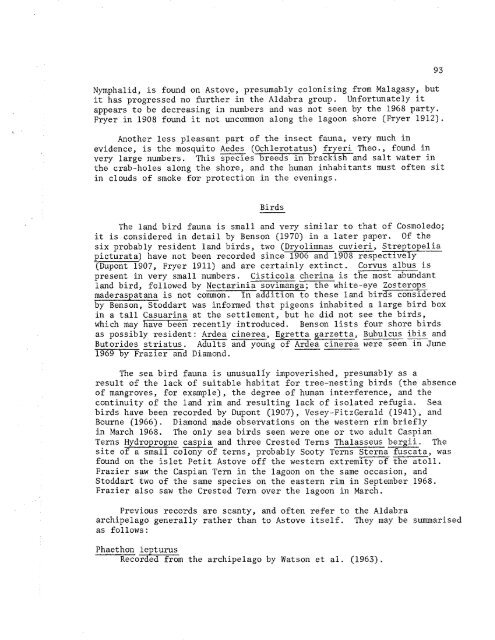ATOLL RESEARCH BULLETIN - Smithsonian Institution
ATOLL RESEARCH BULLETIN - Smithsonian Institution
ATOLL RESEARCH BULLETIN - Smithsonian Institution
Create successful ePaper yourself
Turn your PDF publications into a flip-book with our unique Google optimized e-Paper software.
Nymphalid, is found on Astove, presumably colonising from Malagasy, but<br />
it has progressed no further in the Aldabra group. Unfortunately it<br />
appears to be decreasing in numbers and was not seen by the 1968 party.<br />
Fryer in 1908 found it not uncommon along the lagoon shore (Fryer 1912).<br />
Another less pleasant part of the insect fauna, very much in<br />
evidence, is the mosquito Aedes (Ochlerotatus) -- fryeri Theo., found in<br />
very large numbers. This species breeds in brackish and salt water in<br />
the crab-holes along the shore, and the human inhabitants must often sit<br />
in clouds of smoke for protection in the evenings.<br />
- Birds<br />
The land bird fauna is small and very similar to that of Cosmoledo;<br />
it is considered in detail by Benson (1970) in a later paper. Of the<br />
six probably resident land birds, two (Dryolimnas cuvieri, Streptopelia<br />
picturata) have not been recorded since 1906 and 1908 respectively<br />
(Dupont 1907, Fryer 1911) and are certainly extinct. Corvus albus is<br />
present in very small numbers. Cisticola cherina is the most abundant<br />
land bird, followed by Nectarinia sovimanga; the white-eye Zostero s<br />
h-4-<br />
maderaspatana is not common. In addition to these land bir s considered<br />
by Benson, Stoddart was informed that pigeons inhabited a large bird box<br />
in a tall Casuarina at the settlement, but he did not see the birds,<br />
which may have been recently introduced. Benson lists four shore birds<br />
as possibly resident: Ardea cinerea, Egretta garzetta, Bubulcus ibis and<br />
Butorides striatus. Adults and young of Ardea cinerea were seen in June<br />
1969 by Frazier and Diamond.<br />
The sea bird fauna is unusuali~ impoverished, presumably as a<br />
result of the lack of suitable habitat for tree-nesting birds (the absence<br />
of mangroves, for example), the degree of human interference, and the<br />
continuity of the land rim and resulting lack of isolated refugia. Sea<br />
birds have been recorded by Dupont (1907), Vesey-FitzGerald (1941), and<br />
Bourne (1966). Diamond made observations on the western rim briefly<br />
in March 1968. The only sea birds seen were one or two adult Caspian<br />
Terns Hydroprogne caspia and three Crested Terns Thalasseus bergii. The<br />
site of a small colony of terns, probably Sooty Terns Sterna fuscata, was<br />
found on the islet Petit Astove off the western extremity of the atoll.<br />
Frazier saw the Caspian Tern in the lagoon on the same occasion, and<br />
Stoddart two of the same species on the eastern rim in September 1968.<br />
Frazier also saw the Crested Tern over the lagoon in March.<br />
Previous records are scanty, and often refer to the Aldabra<br />
archipelago generally rather than to Astove itself. They may be swnmarised<br />
as follows:<br />
Phaethon lepturus<br />
Recorded from the archipelago by Watson et al. (1963).

















